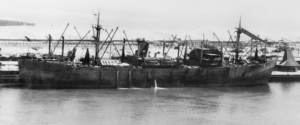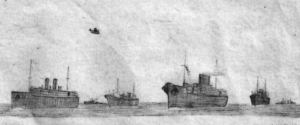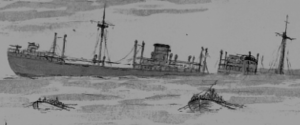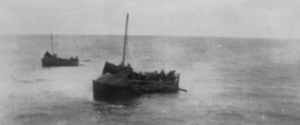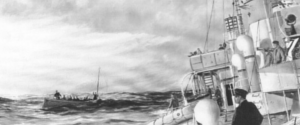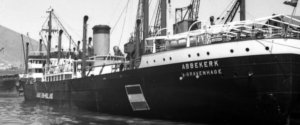Safe at Fremantle: “We thank you God!”

Just before dawn on March 4, as I sat up on that cold, windswept deck, I sighted a flickering light. It was the beacon outside Fremantle Harbor! And what a sight it was!
The pilot boarded our ship a few hours later and took us in through the minefield. We proceeded slowly inward. Fifteen hundred people saved!
It was a cold grey dawn but a rosily happy one to us for it was a place we might never have seen had it not been for our good fortune in escaping enemy vigilance. We dropped anchor at eleven o’clock and at about two-thirty that afternoon steamed up to the dock. As we did so we passed some American submarines and the hull of a burned-out destroyer. I don’t know who it had belonged to but there was nothing left of it now but a shell, a twisted blackened wreck, but as I looked at it I thought of the tragedy, death and heroism with which its ending must have been associated. By four-thirty we commenced to go down the gangplank and to walk aboard a large contingent of wooden cars that were being hauled up alongside our dock. We were a tired, dirty, unshaven but happy bunch of refugees who truthfully could raise their faces up to the sky and silently or openly say: “We thank you, God!”
Flight surgeon Captain James E. Crane, Far East Air Force
When we arrived at Fremantle we still had a grenade in the breech of our gun. We asked approval from the authorities to remove this to a distant sandbar in the mouth of the river. Everybody who wanted to see and hear this show came to witness it. A large fountain of sand meant for everybody on board, specially the crew, that the nerve racking journey through the waters of the Dutch East Indies was at an end.
We had been very lucky. Off the twenty four ships that had left Tjilatjap with us, only thirteen arrived at their destination! The future of the survivors of those sunken ships was very uncertain, particularly if they had been picked up by the Japanese.
Yes, we were lucky indeed, even though we did not realize this at first.
Adriaan Kik, ass. engineer on Abbekerk
On March 8 the Dutch on the Dutch East Indies surrender. Japan now controls the whole Southwest Pacific and they are clearly not about to stop there: Large fleets enter deep into the Indian Ocean, intentions unknown.
Leaving Tjilatjap on March 2:
- Janssens (2071 brt)
Losses (merchant ships only)
4 March Enggano (Dutch): The cargo ship was bombed and damaged by a floatplane from Takao on the 1st. The burning and abandoned ship was scuttled by shelling by Chikuma and Urakaze . Francol (British): The tanker was shelled and sunk in the Indian Ocean 300 nautical miles (560 km) south of Java by Arashi, Atago, Maya, Nowaki, Takao with the loss of all but two crew. Manipi (Dutch): The cargo ship was bombed and sunk off Tjilatjap by the Japanese. Raised, repaired and put in Japanese service as Mainici Maru. Merkus (Dutch): The cargo ship was shelled and sunk in the Indian Ocean north east of Cocos Island by submarine I-7 . Survivors eventually made it to Sumatra. Le Maire (Dutch); torpedoed by submarine I7, no survivors. Duijmear van Twist (1030) Opgebracht door Atago Tjisoera (Dutch) Opgebracht door Arashio 5 March Tohiti (Dutch): The passenger/cargo ship was bombed and sunk at Tjilatjap. Raised by the Japanese, but not repaired. Scrapped in 1945, post War.
6 March Pasir (Dutch): The Cargo Ship was scuttled at Tjilatjap to prevent capture. Raised and scrapped in 1946. Poseidon (Dutch): The tanker was scuttled off Tjilatjap to prevent capture by the Japanese. Raised, repaired and put in Japanese service as Hosei Maru in 1942. Poelau Bras (9278) escaped Tjilatjap succesfully on the 27th but was recalled to Wijnkopsbay to load passengers. Left on March 6 and later that day sunk by planes with heavy loss of life. One of the victims was Master J.E Hellings of the Poelau Tello, sunk in Sourabaya a month earlier. Hellings was Master of Moena 1,5 year earlier and - with his crew - responsible for saving the burning Abbekerk during the Blitz in London. 7 March Taiyuan (Britisch): The cargo liner was shelled and sunk in the Indian Ocean off Christmas Island by Haruna, Hamakaze, KongÅ and Urakaze (all Imperial Japanese Navy). Woolgar (Norway): The cargo ship was bombed and sunk in the Pacific Ocean 150 nautical miles (280 km) south west of Tjilatjap, Netherlands East Indies by Japanese aircraft.
Source:
- https://en.wikipedia.org/wiki/List_of_shipwrecks_in_February_1942
- "De Nederlandse Koopvaardij in de Tweede Wereldoorlog" by L.L. von Münching

